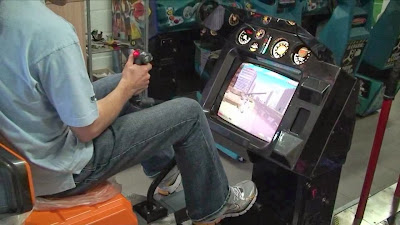By David Campbell
 Blackpool was the place most families chose as their holiday destination in the 80s and early 90s. This was fine by me as it had some of the best arcades I’d seen. They were better furnished than our local arcades, possibly due to space, but more likely due to the booming tourist cash that went into them. I know I spent many pounds in there over the years.
Blackpool was the place most families chose as their holiday destination in the 80s and early 90s. This was fine by me as it had some of the best arcades I’d seen. They were better furnished than our local arcades, possibly due to space, but more likely due to the booming tourist cash that went into them. I know I spent many pounds in there over the years.
Because of this, Blackpool arcades had some huge machines. They had all the standard cabinets and games you’d expect, but I remember experiencing something new whilst on holiday - sit down and hydraulic cabinets. Games such as Out Run, After Burner, Wec Le Mans, Thunder Blade, Space Harrier, and Starblade.
I distinctly remember sitting in the Out Run cabinet for the first time, and being genuinely amazed that it let you pick the soundtrack for your game. Wec Le Mans was a huge cabinet that rotated when you turned - one of the first times I had felt sick whilst playing a game.
 Games back then had the chance to terrify and excite you all at once. The first time I sat in Thunder Blade, and it asked you to make sure you had literally fastened your seatbelt.. I thought I was going to actually take off! Along side Thunder Blade was Space Harrier. A huge cabinet that lurched around to your command was amazing. It was also expensive. At this time, most standard games were 10p or 20p per play. Space Harrier was 50p. But it was so worth it.
Games back then had the chance to terrify and excite you all at once. The first time I sat in Thunder Blade, and it asked you to make sure you had literally fastened your seatbelt.. I thought I was going to actually take off! Along side Thunder Blade was Space Harrier. A huge cabinet that lurched around to your command was amazing. It was also expensive. At this time, most standard games were 10p or 20p per play. Space Harrier was 50p. But it was so worth it.
You could now buy home computer conversions of the popular arcade games, but the arcades still had something that the computers couldn't deliver, no matter how close a conversion.. the huge cabinets and unique controls. You couldn’t by steering wheels, flight yokes and guns for your computer back then (although they would come eventually), so the arcade still held something unique that encouraged you to part with you (or your parents) hard earned cash.
Unfortunately, all that was about to change..
Unfortunately, all that was about to change..
The 1990s
 By the late 90s, arcades were all but dead. There were still some great games released (the Virtua Fighter series, Ferrari Challenge, Virtua Cop series, Sega Rally, Time Crisis etc), but home consoles delivered arcade quality ports. The Sega Saturn, Playstation, PS2 and Dreamcast allowed you to “own” a whole arcade, albeit without the cabinets and controls of their arcade counterparts. Arcades could no longer entice the crowds they previously had.
By the late 90s, arcades were all but dead. There were still some great games released (the Virtua Fighter series, Ferrari Challenge, Virtua Cop series, Sega Rally, Time Crisis etc), but home consoles delivered arcade quality ports. The Sega Saturn, Playstation, PS2 and Dreamcast allowed you to “own” a whole arcade, albeit without the cabinets and controls of their arcade counterparts. Arcades could no longer entice the crowds they previously had.
Home console arcade ports were great for a while, but then nostalgia seemed to kick in. People yearned for the games they had played as kids. Some “retro” compilations were released, and they satisfied some appetites, but it wasn't enough. You could only play the games provided in the compilation. However, a very clever chap named Nicola Salmoria took things into his own hands and created a program for the PC. It was called MAME.
Whilst some people find MAME controversial, it allowed arcade junkies to once again play “real” versions of they games they loved and yearned for. All of a sudden, people could access over 4,000 arcade games right on their home PC.
This seemed to rekindle the love of arcade games, as people played them on the PC but found they wanted more. Playing the game wasn’t enough; they wanted the proper arcade experience. No one ever sat at an arcade machine and played it with a keyboard. They stood up. They mashed buttons and rattled joysticks. They held onto the cabinet. This was the element that was missing.
People like me that had grown up in the arcades now mostly had jobs, and a little disposable income. With a smattering of DIY handiwork, some MDF and lashings of paint, you could actually build your own arcade cabinet.
At first, it was a little complex to use real arcade controls with your PC. It generally involved hacking apart a keyboard and dabbing solder everywhere, but now you can buy an interface the size of a matchbox which allows you to easily screw in connections and add a myriad of controls; joysticks, trackballs, light guns, rotary joysticks, spinners, flight yokes.. they’re all available and (fairly) easy to connect to your computer.
To feed my arcade addiction and my nostalgia, I built myself a MAME cabinet. It took a lot of planning, deciding on controls and so on, but it’s an awesome thing to own, as now I can relive and recapture the giddy excitement I felt as a four year old. Playing MAME in a cabinet is a world apart from playing MAME on anything else (especially when you actually insert a coin to play the game), and it only took me a week to build.
If you love arcade games, I would strongly encourage you think about building (or buying) a MAME cabinet. I promise, you won’t regret it!
A great article by David Campbell as our Guest Blogger -
you can read part one to this here:
http://gamesyouloved.blogspot.co.uk/2013/11/evolution-of-arcade-junkie-part-one-of.html
A great article by David Campbell as our Guest Blogger -
you can read part one to this here:
http://gamesyouloved.blogspot.co.uk/2013/11/evolution-of-arcade-junkie-part-one-of.html



No comments:
Post a Comment
Note: only a member of this blog may post a comment.